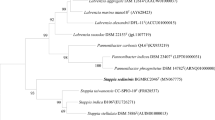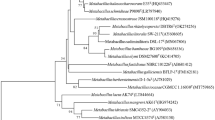Abstract
A novel Gram-stain negative, aerobic, motile, rod-shaped bacterium was isolated from Sesame (Sesamum indicum L.) rhizosphere soil. Based on the 16S rRNA gene similarity value (99.4–98.6%) obtained with phylogenetically closely related strains and through analyses of their house keeping genes (atpD, infB and rpoB), the strain SI-P133T was delineated among the species of the genus Pseudomonas and was subjected to polyphasic taxonomic analysis. It was a chemoorganotroph which grew at wide range of temperature (4–45 °C), pH (5.5–9.5) and NaCl concentrations (0–7% (w/v). DNA–DNA hybridization values with closely related type strains DSM 9751T, DSM 19095T, DSM 21509T, ICMP 9151T and DSM 6929T ranged from 23.1 to 44.2%. The most abundant fatty acids were C16:0, C10:0 3-OH, summed feature 3 (comprising C16:1 ω7c and/or C16:1 ω6c), C17:0 cyclo and C12:0 3-OH. The major isoprenoid quinone system was ubiquinone 9 (Q-9) and the G+C content was 61.3 mol%. The major polar lipids of the strain SI-P133T were diphosphatidylglycerol, phosphatidylglycerol and phosphatidylethanolamine. With regard to prospective use in agriculture, plant growth-promoting properties of the strain were tested and plant growth-promotion was demonstrated under in vitro conditions. Based on the various polyphasic taxonomic traits analysed, the strain SI-P-133T was novel and placed within the genus Pseudomonas. Hence we propose a novel species named Pseudomonas sesami sp. nov., for which the type strain is SI-P133T (=NCIMB 14519T = KCTC 22518T).


Similar content being viewed by others
References
Baldani JI, Reis VM, Videira SS, Boddey LH, Baldani VLD (2014) The art of isolating nitrogen fixing bacteria from non-leguminous plant using N-free semi-solid media: a practical guide for microbiologists. Plant Soil 384:413–431
Brady C, Cleenwerck I, Venter S, Vancanneyt M, Swings J, Coutinho T (2008) Phylogeny and identification of Pantoea species associated with plants, humans and the natural environment based on multilocus sequence analysis (MLSA). Syst Appl Microbiol 31:447–460
Cashion P, Hodler-Franklin MA, McCully J, Franklin M (1977) A rapid method for base ratio determination of bacterial DNA. Anal Biochem 81:461–466
Cochran WG (1950) Estimation of bacterial densities by means of the “Most Probable Number”. Biometrics 6:105–116
DeLong EF (1992) Archaea in coastal marine environments. Proc Natl Acad Sci USA 89:5685–5689
Dittmer JC, Lester RL (1964) A simple, specific spray for the detection of phospholipids on thin-layer chromatograms. J Lipid Res 5:126–127
Ezaki T, Hashimoto Y, Yabuuchi E (1989) Fluorometric deoxyribonucleic acid deoxyribonucleic acid hybridization in microdilution wells as an alternative to membrane filter hybridization in which radioisotopes are used to determine genetic relatedness among bacterial strains. Int J Syst Bacteriol 39:224–229
Felsenstein J (1981) Evolutionary trees from DNA sequences: a Maximum Likelihood approach. J Mol Evol 17:368–376
Fitch WM (1971) Toward defining the course of evolution: minimum change for a specific tree topology. Syst Zool 20:406–416
Gardan L, Shafik H, Belouin S, Broch R, Grimont F, Grimonth PAD (1999) DNA relatedness among the pathovars of Pseudomonas syringae and description of Pseudomonas tremae sp. nov. and Pseudomonas cannabina sp. nov. (ex Sutic and Dowson 1959). Int J Sys Evol Microbiol 49:469–478
Kim M, Oh HS, Park SC, Chun J (2014) Towards a taxonomic coherence between average nucleotide identity and 16S rRNA gene sequence similarity for species demarcation of prokaryotes. Int J Sys Evol Microbiol 64:346–351
Kroppenstedt RM (1982) Separation of bacterial menaquinones by HPLC using reverse phase (RP 18) and a silver loaded ion exchanger as stationery phases. J Liq Chromatogr 5:2359–2367
Loper JE, Hassan KA, Mavrodi DV, Davis EW, Lim CK, Shaffer BT et al (2012) Comparative genomics of plant-associated Pseudomonas spp.: insights into diversity and inheritance of traits Involved in multitrophic interactions. PLoS Genet 8:e1002784
Madhaiyan M, Poonguzhali S, Ryu JH, Sa TM (2006) Regulation of ethylene levels in canola (Brassica campestris) by 1-aminocyclopropane-1-carboxylate deaminase-containing Methylobacterium fujisawaense. Planta 224:268–278
Madhaiyan M, Poonguzhali S, Sa T (2007) Characterization of 1-aminocyclopropane-1-carboxylate (ACC) deaminase containing Methylobacterium oryzae and interactions with auxins and ACC regulation of ethylene in canola (Brassica campestris). Planta 226:867–876
Madhaiyan M, Poonguzhali S, Kwon SW, Sa TM (2009) Methylobacterium phyllosphaerae sp. nov., a pink-pigmented, facultative methylotroph from the phyllosphere of rice. Int J Syst Bacteriol 59:22–27
Madhaiyan M, Poonguzhali S, Senthilkumar M, Pragatheswari D, Lee KC, Lee JS (2013) Methylobacillus rhizosphaerae sp. nov., a novel plant-associated methylotrophic bacterium isolated from rhizosphere of red pepper. Antonie Van Leeuwenhoek 103:475–484
Madigan MT, Martinko JM, Stahl DA, Clark DP (2012) Brock biology of microorganisms, 13th edn. Pearson-Benjamin Cummings, San Francisco
Mesbah M, Premachandran U, Whitman WB (1989) Precise measurement of the G+C content of deoxyribonucleic acid by high-performance liquid chromatography. Int J Syst Bacteriol 39:159–167
Migula W (1894) Über ein neues System der Bakterien. Arb Bakteriol Inst Karlsruhe 1:235–238
Minnikin DE, O’Donnell AG, Goodfellow M, Alderson G, Athalye M, Schaal A, Parlett JH (1984) An integrated procedure for the extraction of bacterial isoprenoid quinones and polar lipids. J Microbiol Methods 2:233–241
Nautiyal CS (1999) An efficient microbiological growth medium for screening phosphate solubilizing microorganisms. FEMS Microbiol Lett 170:265–270
Palleroni NJ (2004) Genus I. Pseudomonas. In: Garrity GM, Brenner DJ, Krieg NR, Staley JT (eds) The Proteobacteria: Part –B, The Gammaproteobacteria, vol 2, 2nd edn. Springer, New York
Panpatte DG, Jhala YK, Shelat HN, Vyas RV (2016) Pseudomonas fluorescens: a promising biocontrol agent and PGPR for sustainable agriculture. In: Singh DP, Singh HB, Prabha R (eds) Microbial inoculants in sustainable agricultural productivity. Springer, New Delhi, pp 257–270
Parte AC (2014) LPSN-list of prokaryotic names with standing in nomenclature. Nucleic Acids Res 42:D613–D616
Penrose DM, Glick BR (2003) Methods for isolating and characterizing ACC deaminase-containing plant growth-promoting rhizobacteria. Physiol Plant 118:10–15
Poonguzhali S, Madhaiyan M, Sa TM (2006) Cultivation-dependent characterization of rhizobacterial communities from field grown Chinese cabbage Brassica campestris ssp. Pekinensis and screening of potential plant growth promoting bacteria. Plant Soil 286:167–180
Preston GM (2004) Plant perceptions of plant growth-promoting Pseudomonas. Philos Trans R Soc Lond B 359:907–918
Ross HNM, Grant WD, Harris JE (1985) Lipids in archaebacterial taxonomy. In: Goodfellow M, Minnikin DE (eds) Chemical methods in bacterial systematics. Academic Press, London, pp 289–300
Saitou N, Nei M (1987) The neighbor-joining method: a new method for reconstructing phylogenetic trees. Mol Biol Evol 4:406–425
Sasser M (2001) (revised) Identification of bacteria by gas chromatography of cellular fatty acids. Technical Note# 101, MIDI, Inc., Newark
Stackebrandt E, Goebel B (1994) Taxonomic note: a place for DNA–DNA reassociation and 16S rRNA sequence analysis in the present species definition in bacteriology. Int J Sys Evol Microbiol 44:846–849
Tamura K, Stecher G, Peterson D, Filipski A, Kumar S (2013) MEGA6: molecular evolutionary genetics analysis version 6.0. Mol Biol Evol 30:2725–2729
Wayne LG, Brenner DJ, Colwell RR, Grimont PAD, Kandler O, Krichevsky MI, Moore LH, Moore WEC, Murray RGE, Stackebrandt E, Starr MP, Trüper HG (1987) International committee on systematic bacteriology. Report of the Ad Hoc committee on reconciliation of approaches to bacterial systematics. Int J Syst Bacteriol 37:463–464
Wilson K (1997) Preparation of genomic DNA from bacteria. In: Ausubel FM, Brent R, Kingston RE, Moore DD, Seidman JG, Smith JA, Struhl K (eds) Current protocols in molecular biology. Wiley, New York, pp 241–245
Yoon SH, Ha SM, Kwon S, Lim J, Kim Y, Seo H, Chun J (2017) Introducing EzBioCloud: a taxonomically united database of 16S rRNA and whole genome assemblies. Int J Syst Evol Microbiol. doi:10.1099/ijsem.0.001755
Acknowledgements
Authors are grateful to Professor Jean Euzéby for the support in the Latin etymology of the new species name. The authors would like to extend their sincere appreciation to the Deanship of Scientific Research at King Saud University for its funding of this research through the Research Group project No RGP-213.
Author information
Authors and Affiliations
Corresponding author
Electronic supplementary material
Below is the link to the electronic supplementary material.
Rights and permissions
About this article
Cite this article
Madhaiyan, M., Poonguzhali, S., Saravanan, V.S. et al. Pseudomonas sesami sp. nov., a plant growth-promoting Gammaproteobacteria isolated from the rhizosphere of Sesamum indicum L.. Antonie van Leeuwenhoek 110, 843–852 (2017). https://doi.org/10.1007/s10482-017-0859-x
Received:
Accepted:
Published:
Issue Date:
DOI: https://doi.org/10.1007/s10482-017-0859-x




